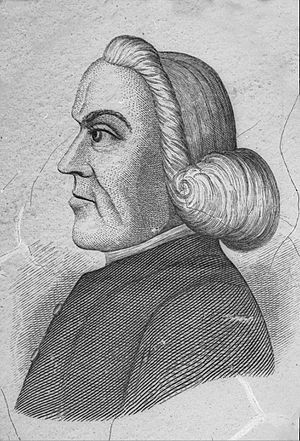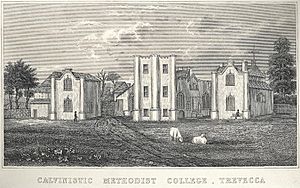Howell Harris facts for kids
Quick facts for kids
Howell Harris
|
|
|---|---|
 |
|
| Born | 23 January 1714 Talgarth, Brecknockshire, Wales
|
| Died | 21 July 1773 (aged 59) |
| Resting place | Talgarth |
| Nationality | Welsh |
| Occupation | Preacher |
| Known for | Founder of the Calvinistic Methodist Church |
Howell Harris (Welsh: Howel Harris; 23 January 1714 – 21 July 1773) was an important Welsh preacher. He was one of the main leaders of a big religious movement in Wales during the 1700s, known as the Welsh Methodist revival. He worked alongside other famous preachers like Daniel Rowland and William Williams Pantycelyn.
Contents
Howell Harris's Early Life
Howell Harris was born on January 23, 1714, in a place called Trefeca, near Talgarth in Brecknockshire, Wales. He was the youngest of five children. His father, Howel ap Howel, was a carpenter. The family had moved to Trefeca in 1700. Howell's older brother, Joseph, became an astronomer and worked at the Royal Mint in London. His other brother, Thomas, was a successful tailor.
His Religious Journey
In March 1735, Howell Harris had a very important religious experience. This happened after he heard a sermon about the importance of taking Holy Communion. For several weeks, he thought deeply about his beliefs. This led to a powerful moment during Communion in May 1735, where he felt a great sense of joy and forgiveness.
After this experience, he immediately started sharing his beliefs with others. He held meetings in his home to encourage people to find the same sense of forgiveness and peace.
Howell wanted to become a priest in the Church of England, but he was not accepted. This was because his views were seen as too "Methodist" at the time. Instead, he became a traveling preacher. He worked tirelessly to spread his message across Wales. His preaching was often dangerous, and he faced hardship and opposition before he gained many followers. From 1738, a local squire named Marmaduke Gwynne became one of his early supporters.
Later Years and Legacy
In 1750, Harris decided to stay at his home in Trefeca for a while. He had some disagreements with another preacher, Daniel Rowland, and faced personal challenges. In 1752, he was inspired by the Moravians to start a religious community at his home. He called it Teulu Trefeca, which means "The Trefeca family," and he was seen as the "Father" of this community.
Howell Harris did not stop preaching forever. He started traveling and preaching again in 1763, after he and Daniel Rowland made up. He passed away ten years later, on July 21, 1773. He was buried near his birthplace in Talgarth. It is said that 20,000 people attended his funeral, showing how important he was to many. There is also a memorial to him in Rhydyclafdy, where he once preached.
Howell Harris is known as the founder of the Presbyterian Church of Wales, which is also called the Calvinistic Methodist Church.
Howell Harris's Writings
Howell Harris kept detailed diaries and carefully saved all the letters he sent and received during his time as a preacher. These writings give us a unique look into the Welsh Methodist revival from his own perspective.
For many years after his death, his papers were not looked after. But in the 1880s, a man named O. M. Edwards realized how important they were. He suggested they should be properly cared for. At that time, Harris's old home in Trefeca had become a college. The deputy head of the college, Edwin Williams, took on the job of organizing the papers.
The papers stayed at Trefeca until 1910. Then, the Presbyterian Church of Wales decided to create a special committee to look after them and study them. It became clear that there was a huge amount of work to do. Many of the papers were in Latin, and it would take a long time and a lot of money to prepare them for publishing.
In 1913, it was decided that it would be better to create a Historical Society for the Presbyterian Church of Wales. This society would publish a regular magazine that would include some of Harris's papers.
Around 1932, the papers were moved from Trefeca to the church's college in Aberystwyth. In 1934, these papers, along with others from another college, were taken to be stored safely at the National Library of Wales. They are still kept there today. A book about Howell Harris, called Howell Harris: From Conversion to Separation, 1735–1750, was published in 2000 by Revd Dr Geraint Tudur.



